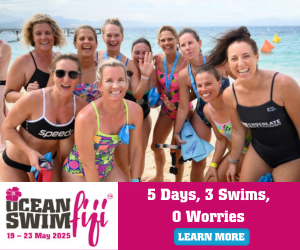Don’t you worry,
It’s gonna be alright,
‘Cause I’m always ready,
I won’t let you outta my sight,
I’ll be ready.
If you haven’t picked it already, it’s the chorus from the theme song for the 80’s hit TV show, Baywatch.
As a lifesaver for more than 25 years and a lover of 80’s music, I guess you could say this song is in my DNA.
As an open water swimmer, it should also be in yours.
That’s because every time you enter the water with your swimming buddies, you should share the responsibility for each others safety and be ready to assist if needed.
It starts with a check-in before you swim; is everyone feeling ok and up for it? Is everyone wearing a bright swim cap?
Then, plan a swim that’s within everyone’s limits (or split into groups), include regular checkpoints and ensure everyone is on board. Pair up swimmers of similar speed, with each committing to keeping the other in their sights throughout the swim.
Should you come across a swimmer in difficulty, it’s time to channel your inner Mitch Buchannon.
Swim to within speaking distance, but not reaching distance just yet. Even the nicest swimmers in difficulty can act irrationally and may lock onto you, pushing you under the water to keep themselves above.
Next, ask them what they’re having trouble with.
If it’s heightened anxiety or a panic attack, calmly reassure them and put together a plan for what will happen next. Will you both resume your swim, return to shore or signal for assistance?
For tired swimmers, they need to recharge. Start by having them float and take in some deep breaths. In almost all cases, it’s best to cut the swim short at this stage. If the shore is too far away, then signal for assistance.
Cramping seriously cramps the style of a swimmer, but it’s mostly harmless. Have the swimmer float on their back and extend their leg while you gently apply pressure and massage the affected area. For toe cramps, massage the surrounding muscles and move the toes backward and forward to help release the cramp.
For more serious injuries or conditions, be a calming influence, call in others to support you and plan how you will manage the situation and safely exit the water. Nearby surfers or anyone with a floatation device will be invaluable, as will the local lifesaving patrol who you can get the attention of by raising your hand. Even on unpatrolled beaches, raising your hand is still a great way to let those onshore know an urgent rescue is needed, and to call 000 to activate a callout service.
A safe swim is a fun swim, so just remember, forever and always, be ready.
First published on oceanfit.com.au





























